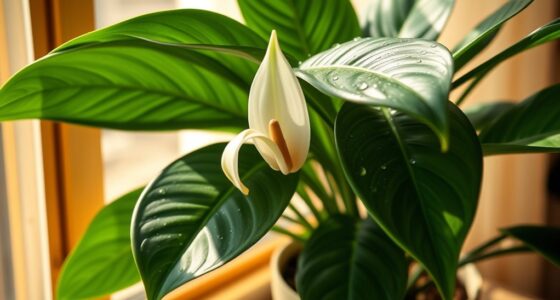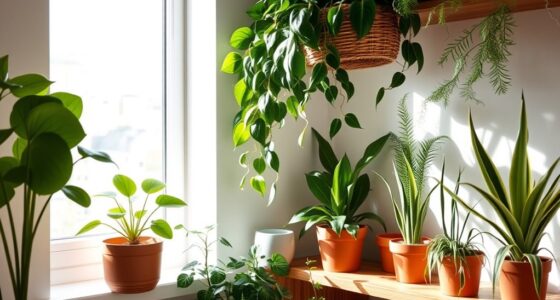Aloe vera is a versatile plant you can grow easily indoors or outdoors. Beyond soothing burns, you can use its gel in skincare routines, like face masks and moisturizers, or add it to smoothies for added health benefits. Make sure to place your aloe in bright, indirect sunlight and water only when the soil is dry. Proper care helps your plant thrive and reveal its many uses—there’s much more to discover if you continue exploring.
Key Takeaways
- Aloe vera can be propagated easily through offsets or pups for expanding your collection.
- The gel is versatile, used in recipes, smoothies, face masks, and homemade skincare products.
- Provide bright, indirect sunlight and water only when soil is fully dry to ensure healthy growth.
- Properly preparing aloe involves peeling leaves and washing gel thoroughly to avoid skin irritation.
- Regular removal of dead leaves and avoiding overwatering promote a healthy, thriving aloe vera plant.

Aloe vera is a versatile plant loved for its healing properties and easy care. Whether you’re new to gardening or a seasoned plant lover, you’ll find that this succulent is remarkably simple to maintain and even easier to multiply. If you’re interested in expanding your aloe collection, plant propagation is straightforward. You can grow new plants from offsets or pups that form around the base of the mature plant. Gently remove these pups, making sure they have some roots attached, and plant them in well-draining soil. Within a few weeks, they’ll establish themselves and start growing. Propagation is a cost-effective way to increase your aloe family, and it allows you to share the plant’s benefits with friends and family. A key aspect of healthy growth is ensuring proper color temperature, which can influence the plant’s overall health and appearance.
Beyond its reputation for soothing burns, aloe vera is also a star ingredient in many recipes that boost health and beauty routines. You can incorporate the gel into smoothies, face masks, or even homemade lotions. The gel’s soothing, moisturizing properties make it a popular choice for skin care, and mixing it into aloe vera recipes at home is a fun way to harness these benefits naturally. When preparing aloe vera for recipes, always use a sharp knife to cut away the outer leaves, then peel back the thick skin to access the clear gel inside. Be sure to wash the gel thoroughly to remove any residual latex, which can be irritating. Fresh gel blends beautifully into drinks for a nutritious boost or into DIY skincare treatments that refresh your skin.
Taking care of your aloe vera plant involves more than just watering it occasionally; it’s about creating the right environment. Place your aloe in bright, indirect sunlight, and water only when the soil feels completely dry. Overwatering is a common mistake that can lead to root rot, so remember: less is more. The plant prefers well-draining soil or cactus mix, which prevents excess moisture from lingering around the roots. During the growing season, you might give it a light fertilizer once a month, but it generally thrives with minimal fuss. As it matures, your aloe vera will develop the iconic thick, fleshy leaves, ready for both propagation and culinary use.
Frequently Asked Questions
Can Aloe Vera Improve Skin Conditions Beyond Burns?
Aloe vera can definitely improve skin conditions beyond burns. You might notice better skin hydration and a reduction in inflammation, making your skin feel softer and more refreshed. It’s also known as an effective acne treatment, helping to soothe irritated skin and reduce redness. Incorporating aloe vera into your skincare routine can boost overall skin health, providing natural relief for various skin issues while keeping your skin well-hydrated and balanced.
How Often Should I Water My Aloe Vera Plant?
Wondering about watering frequency for your aloe vera? You should water when the soil moisture feels dry and the top inch looks parched. Typically, watering every three weeks works well, but it depends on your environment. Overwatering can cause root rot, so it’s better to err on the side of drought. Keep a close eye on soil moisture, and your aloe will thrive happily, healthy, and hydrated.
Is Aloe Vera Safe for Pets?
You wonder if aloe vera is safe for pets. While aloe offers many benefits for humans, pet ingestion can cause issues, as aloe toxicity may lead to vomiting, diarrhea, or other symptoms. It’s best to keep aloe plants out of your pet’s reach and monitor them closely. If you suspect your pet ingests aloe, contact your veterinarian immediately to prevent serious health problems.
Can Aloe Vera Be Used Internally?
You’d think aloe vera would be a miracle for digestion, right? Well, not so fast. While some claim internal benefits, using aloe vera internally isn’t always safe. It can cause unwanted side effects, and its safety for digestion isn’t fully proven. If you’re considering using aloe vera for digestion or internal benefits, it’s best to consult a healthcare professional first. Don’t just assume it’s harmless—be cautious with internal use.
What Are the Signs of Aloe Vera Overuse?
When you overuse aloe vera, you might notice skin irritation, such as redness, itching, or a rash, especially if applied excessively or on sensitive skin. Aloe vera overuse can also cause gastrointestinal issues like cramps or diarrhea if ingested in large amounts. Pay attention to these signs and reduce usage to prevent adverse reactions. Always follow recommended guidelines to enjoy aloe vera’s benefits without risking skin irritation or other side effects.
Conclusion
Now that you know the many ways to care for and use aloe vera, you’ll see it’s more than just a remedy for burns—it’s a versatile plant for your health and beauty. Think of it as your modern-day alchemist, transforming dull skin or minor cuts into glowing results. Keep some handy in your home, and you’ll always be prepared, just like your ancestors once did with their trusty herb gardens. Embrace aloe vera, and let nature work its magic!









